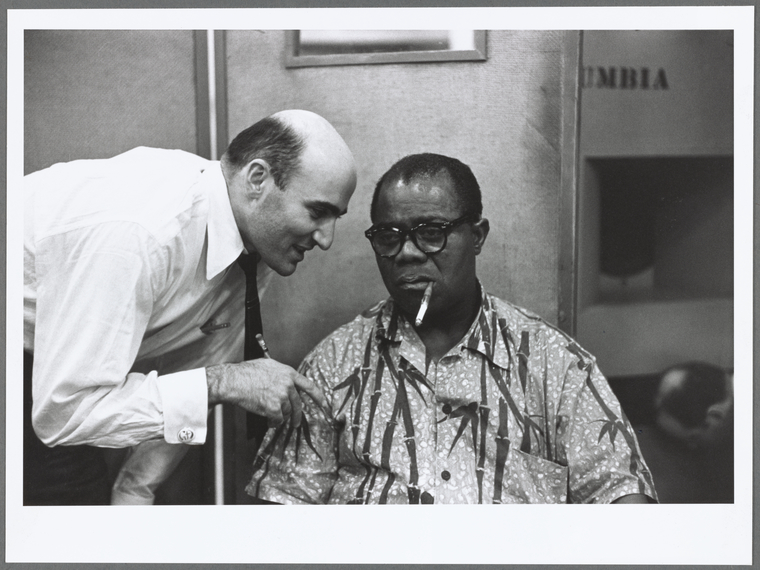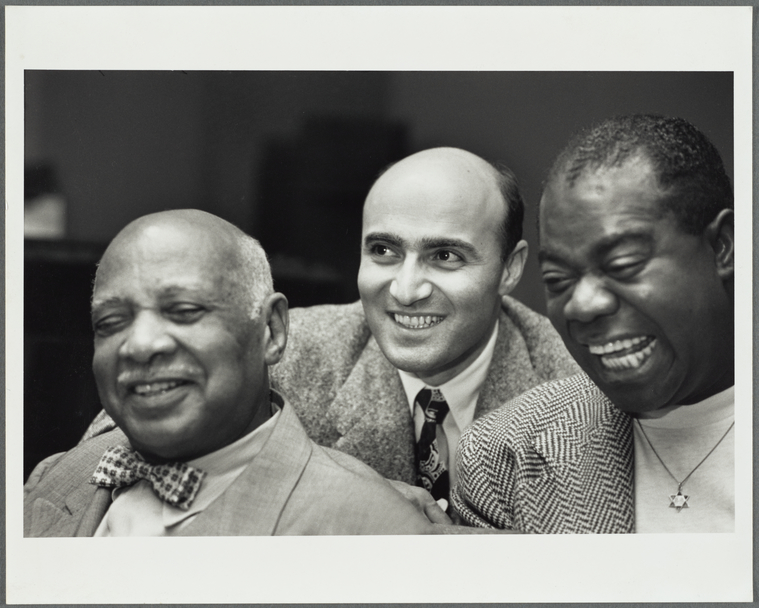George Avakian and Louis Armstrong

George Avakian's lifelong friendship with Louis Armstrong began in 1940 when he, a student at Yale University, was working on the Columbia Records Hot Jazz Classics Series (HJC), which was the first jazz reissue program; it returned to availability many of the important recordings of early jazz of the 1920s. While researching the vaults of Columbia to assemble the series, Avakian discovered a number of unreleased Armstrong sides that would be issued on the first HJC set, King Louis. He eagerly brought a test pressing of one of them, "Chicago Breakdown,” to play for Armstrong, who was performing at the Apollo Theater in Harlem.
He was in the Braddock Bar around the corner... I went over and introduced myself. He said, “Sit down,” and I told him about the test pressing and held it up. He said, “Fine, I’ve got a record player in the dressing room, I’ll listen to it.” Louis was very pleased that this had been found. I told him there’s some others of the Hot Five and Seven, and he couldn’t remember the titles at all. He wanted to hear more of them. This is the way our friendship began, through these unreleased masters. Here I was, a college kid, twenty years old at the time—I didn’t expect to be embraced as it were by Louis, but the next time I came into town we got together and had dinner.

Columbia Hot Jazz Classics series, 1940.
Fourteen years later, Avakian convinced Joe Glaser, Armstrong’s manager, to allow the trumpeter to sign a two-year deal with Columbia. Avakian planned to feature core jazz repertoire, as opposed to the more popular material Armstrong had been recording for Decca Records. The recordings Avakian produced are now regarded as some of Armstrong’s best since the 1920s, and include the studio sessions Louis Armstrong Plays W.C. Handy (1954) and Satch Plays Fats (1955); the (mostly) live albums Ambassador Satch (1955) and Satchmo The Great (1956); and the hit single “Mack The Knife" (1955). The first of these, Plays W.C. Handy, turned out to be one of the very best albums of the trumpeter’s career.
Our friendship was a key factor in the development of new kinds of recordings that Louis hadn’t made, because he just kept doing a lot of the standard repertoire, pop tunes and so on. That isn’t what I wanted to do. I felt the time has come for Louis to make some important statements that were really worthy of him. The first idea once we got going was to do the album of W.C. Handy compositions. Louis said, “You pick the tunes, whichever ones you want.” I got the music from Mr. Handy’s office and sent them to Louis, who was out on the road. He prepared some pretty unusual tunes, like “Chantez Les Bas” which was a lovely thing that I don’t know of another record of. We did [the album] in two days in Chicago. The sessions were absolutely wonderful because the band was well-prepared. Louis threw his heart and soul into this and it went rather rapidly.

Featuring Armstrong’s All Stars (comprised at that time of Velma Middleton, vocals; Trummy Young, trombone; Barney Bigard, clarinet; Billy Kyle, piano; Arvell Shaw, bass; and Barrett Deems, drums), the album showcased explosive solo and ensemble performances by all involved, of material close to Armstrong’s heart. Avakian is credited nearly as much as Armstrong for the artistic success of the record. For all of the musicians on the session, it stood out as a career high point; both Armstrong and Trummy Young later said as much in interviews.

Columbia CL 591, 1954.
In 1955, Avakian produced “Mack The Knife,” one of the best-known of Armstrong’s singles, and a huge pop success. It was the producer’s idea to make a hit out the Kurt Weill song from The Threepenny Opera, but he wasn’t sure who should sing it.
I had no idea of doing it with Louis Armstrong... I suggested it to many people, I suggested it to Dave Brubeck, even the Modern Jazz Quartet. Everybody said, “It’s just too simple, it’s only eight bars over and over again, what can you do with it?” Well, I just kind of gave up on it after a while. Nobody was interested. I’d never thought of Louis.
Avakian’s friend, the trombonist Turk Murphy, had the insight to suggest Armstrong for the song, and even wrote the arrangement the All Stars were to use. Murphy and Avakian visited Armstrong when he was performing in San Francisco.
I had the recording of The Threepenny Opera, original cast, with me, and the music, and Turk had his arrangement with him. We walked in and saw Louis in his dressing room. He always had a record player so we listened to it and he said, “Yeah, that’s great. I’ll do it.”
Avakian used tape overdubbing, a technique he would later use extensively with Miles Davis and other artists, to enable Armstrong to accompany himself on trumpet behind his own vocal; he also recorded a separate version with Weill's widow, Lotte Lenya, in a duet with Armstrong.
Armstrong was the first to make the song a hit, but certainly not the last, as Bobby Darin went on to have massive success with it (essentially copying the Turk Murphy arrangement). It was also recorded by a plethora of other artists, including Ella Fitzgerald, Tito Puente, Tony Bennett, Dave van Ronk, and Marianne Faithfull.
When Armstrong’ contract came up for renewal in 1956, his manager Joe Glaser's demands were not acceptable to Columbia, killing a project that had already been agreed to in principle: an LP teaming Armstrong with the Duke Ellington Orchestra. Avakian knew exactly which tunes he wanted the combined forces to record, all to be arranged, of course, by Ellington and Billy Strayhorn. Instead, Glaser brought the idea of uniting Ellington and Armstrong to Roulette records, which produced an album featuring Ellington with the Armstrong and his All Stars. But Avakian’s more ambitious plan to feature Armstrong with the complete Ellington group never came to fruition.
Avakian remained close friends with the trumpeter until his death in 1971, and long after that he continued to uphold the Armstrong flame. In the 1990s, his scholarly instincts resulted in the discovery of previously unknown, unrecorded Armstrong compositions held by the Library of Congress. Those compositions, as well as previously-unheard music by Bix Beiderbecke, were performed and recorded by musicians under the direction of trumpeter Randy Sandke on the Avakian-produced CD The Re-Discovered Louis and Bix (Nagel-Heyer, 2000). Avakian was also consulted for the reissues of the classic Armstrong albums he produced in the 1950s, and he continues to bear witness to Armstrong’s greatness as a musician and as a human being.
The exhibition "Music For Moderns": The Partnership of George Avakian and Anahid Ajemian, is on view in the Vincent Astor Gallery of The New York Public Library for the Performing Arts through September 24.
All quotations are from interviews or oral histories in the George Avakian and Anahid Ajemian papers, JPB 14.28. Music Division, The New York Public Library for the Performing Arts.
Read E-Books with SimplyE
 With your library card, it's easier than ever to choose from more than 300,000 e-books on SimplyE, The New York Public Library's free e-reader app. Gain access to digital resources for all ages, including e-books, audiobooks, databases, and more.
With your library card, it's easier than ever to choose from more than 300,000 e-books on SimplyE, The New York Public Library's free e-reader app. Gain access to digital resources for all ages, including e-books, audiobooks, databases, and more.
If you don’t have an NYPL library card, New York State residents can apply for a digital card online or through SimplyE (available on the App Store or Google Play).
Need more help? Read our guide to using SimplyE.
Comments
Wonderful article
Submitted by Anahid Avakian Gregg (not verified) on July 25, 2016 - 2:19pm